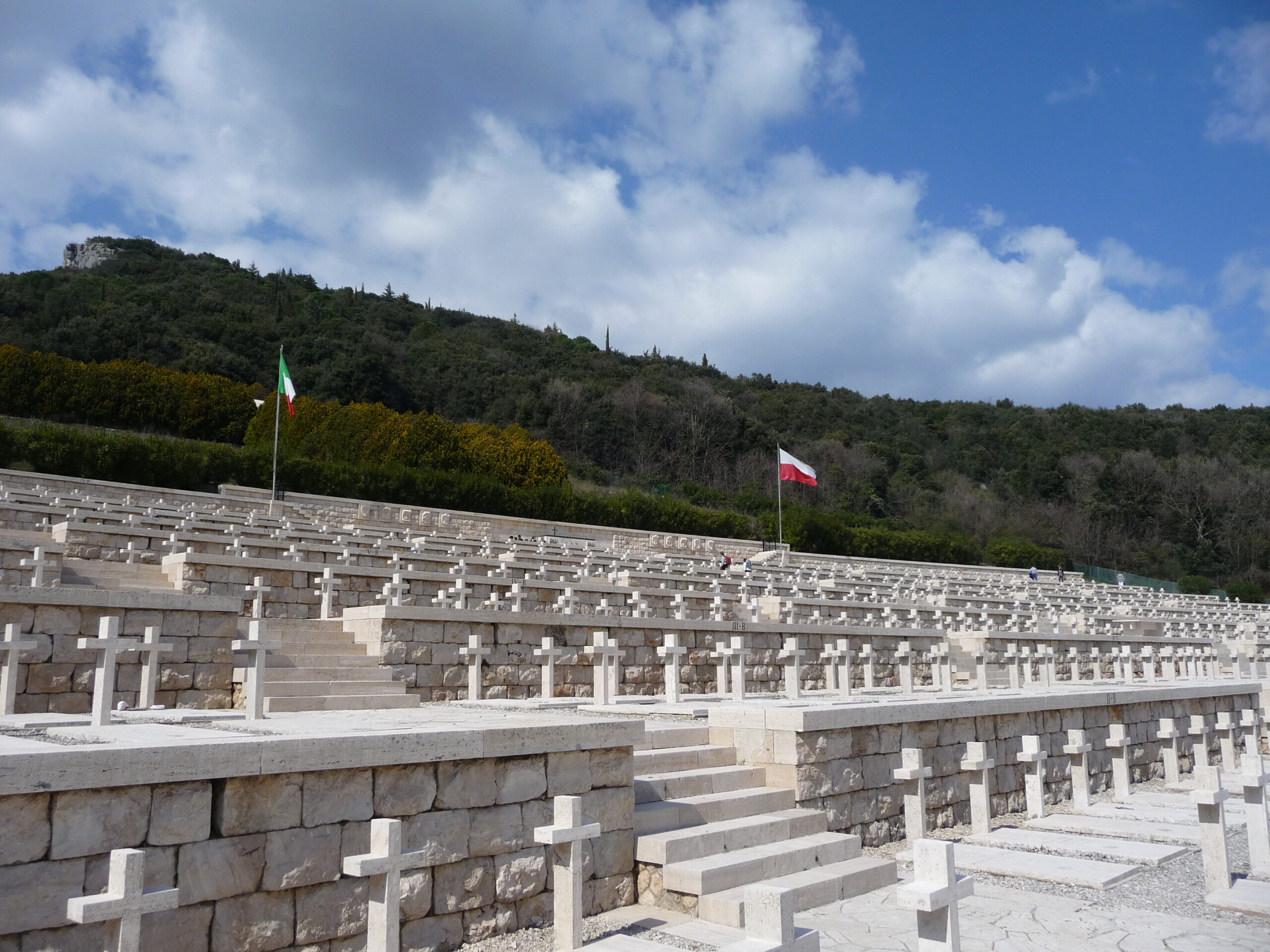There are four war cemeteries in Italy commemorating the participation of the Polish II Corps in the Italian campaign. The largest necropolis is in Bologna, where the unit fought its last battle and ended its campaign in 1945. The others are located in Casamassima and Loreto and – the most famous – on the Monte Cassino hill, where the soldiers of General Władysław Anders played a decisive role in the Battle of Rome and carried out a victorious attack in May 1944.
by Piotr Bejrowski
On July 30, 1941, the Sikorski-Mayski Agreement was signed, under which Polish citizens held in Soviet prisons were released. A year later, these liberated individuals formed the nucleus of the newly established Polish Army in the East. This new military force also encompassed the Polish II Corps, which was formally established on July 21, 1943. The corps embarked on a journey from Iraq through Palestine to Egypt, where the soldiers under General Anders’ command set sail for Italy on December 16, 1943. As part of the British 8th Army, Poles fought in the Italian campaign. They successfully breached the formidable Gustav, Hitler, and Goth Lines, contributing to the liberation of Ancona and Bologna. Following the conclusion of the war, the corps remained stationed in Italy as part of the Allied occupation forces. However, in 1946, the unit was relocated to Great Britain, where it was ultimately disbanded a year later.
On December 21, 1943, Polish soldiers landed in the harbor of Taranto on the sole of the Italian boot. Their journey led them to the first major city along their route, Bari, located in Puglia. Bari hosts the southernmost and smallest of the Polish war cemeteries in Italy. Four hundred twenty-nine soldiers who died in battles on the Gustav Line are buried in Casamassima. The necropolis was consecrated in 1946, and at its heart stands an altar adorned with the image of Our Lady of the Gate of Dawn in Vilnius. Inscribed upon it are the poignant words: “They were not broken by the force of law – they died in a brave and noble way.” The main gate is decorated with a quote from the letter of St. Paul to Timothy: “I have fought a good fight, I have kept the faith, and now there is a crown of righteousness waiting for me.”
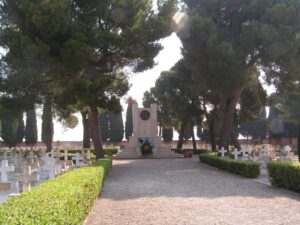
***
The Polish flag was hoisted atop the ruins of the Benedictine monastery on Monte Cassino on May 18, 1944, at 10:20. St. Mary’s bugle call was played, a well-known melody from the Krakow market square. The battle for this pivotal point on the Gustav Line had raged since January, with the Allies relentlessly striving to dislodge the entrenched German forces. It took four concerted attempts before the Allies finally seized control of the hill, with the Polish troops playing a vital role in the decisive assault, executed as part of Operation Diadem. According to British historian Matthew Parker, this battle was “the heaviest and bloodiest of the fights between the Western Allies and the German Wehrmacht on all fronts of World War II.” The defeated compared it with Stalingrad. During the fighting, 923 soldiers of the II Corps died, nearly 3,000 were injured, and 345 were reported missing. A few days after capturing the hill, Allied troops broke through the Gustav Line along the entire stretch of their advance. On June 4, 1944, the Americans entered Rome.
The construction of the cemetery, strategically located in the Valley of Death between the monastery and the towering Hill 593, the site of the bloodiest fighting involving Polish forces, began almost immediately after the end of the battle. The consecration of the necropolis, in the presence of representatives of the Polish government in exile and the command of the Allied troops, took place on September 1, 1945, during a ceremony celebrated in Catholic, Orthodox, Evangelical, and Jewish rites. One thousand sixty-six soldiers were buried in the Valley of Death. The impressive cemetery, beautifully situated and today both a memorial site and a crowded tourist attraction, was built by the soldiers themselves with the support of Italian stonemasons. The construction required leveling the bomb-damaged area and moving 20,000 m³ of earth. The cemetery covers an area of nearly 1,500 m² and its gates are “guarded” by two huge eagles with Polish hussar wings standing on three-meter pilasters. Those entering from the monastery are led through a beautiful avenue with bushes also decorated with state flags.
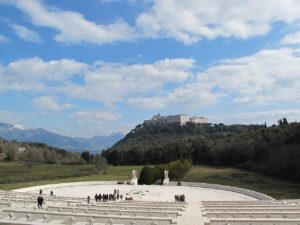
In front of an impressive amphitheater of 9 terraces made of limestone boulders and containing two rows of graves on each level, a 16-meter Virtuti Militari cross (Poland’s highest military decoration) etched into the ground beside an eternal flame. Encircling the cross is an inscription: “Passenger, tell Poland, that we have fallen faithful in its service.” A grand staircase, reaching nearly 50 meters in height, ascends towards an altar bearing the inscription “PAX” (Peace) in Latin and the coats of arms of the fighting units carved in the high wall. Two flags fly above the altar: Polish and Italian. Higher up, towards Hill 593, there is a cross made of a hedge with a 50-meter arm, in the center of which there is a bas-relief of a Polish eagle measuring 6 by 7 meters.
Among the many buried at Monte Cassino is Major Jan Żychoń, a leading Polish intelligence officer who was killed in combat. After the war, participants of the battle were also buried in the cemetery: Field Bishop Józef Gawlina (in 1964), General Anders (in 1970) and General Bronisław Duch, commander of the 3rd Carpathian Rifle Division as part of the II Corps (in 1980). At the entrance of the cemetery, there is a memorial chamber that was opened on the 70th anniversary of the battle. The room presents in three languages (Polish, English, and Italian), the journey of Polish soldiers who followed the campaign trail leading from Soviet prisons to Italian soil. There are several memorial sites in the area, including the monument of the 3rd Division on top of Hill 593 (in line with the monastery and cemetery), the cross of the 5th Kresowa Infantry Division on Hill 575, and a cross honoring the 4th “Skorpion” Regiment. This cross is placed on a Sherman tank wreck that was destroyed by a German mine on May 12, 1944.
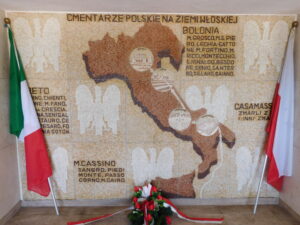
The Polish War Cemetery at Monte Cassino is under the care of the Council for the Protection of Memory of Struggle and Martyrdom. From 2004 to 2009, the cemetery was comprehensively renovated. In 2011, Irena Anders’ ashes were interred next to her husband. The cemeteries of soldiers of other nationalities killed in the battle are less prominent and are located near the town of Cassino, under the monastery hill. There is a British cemetery (with around 5,000 soldiers), and a German cemetery (with approximately 20,000 soldiers).
The Battle of Ancona on the Adriatic Sea (June 18-July 18, 1944), like the Battle of Monte Cassino and Bologna, is commemorated on the Tomb of the Unknown Soldier in Warsaw. The soldiers of the II Corps who died during the battle were buried in nearby Loreto, a town known for the house of Mary of Nazareth, which was moved here by the Crusaders. The Polish cemetery was established in 1944 and is adjacent to the Santa Casa Sanctuary. Its consecration took place on May 6, 1946. One thousand eighty-one soldiers are buried there. The graves are located on three terraces. In the center, on a stone pedestal, there is a mast with the white and red flag of Poland. Similarly to Casamassima, on the altar in the center of the necropolis, there is a painting of Our Lady of the Gate of Dawn — a symbol of the bond of those from the Vilnius region.
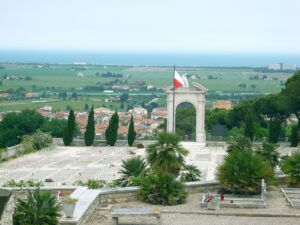
As many as 1,432 soldiers of the II Corps who died in battles on the Gothic Line, in the Apennines, on the Senio River, and during the Battle of Bologna in April 1945 are buried at the Polish War Cemetery in Bologna – San Lazzaro di Savena. It was one of the last battles fought by Allied troops in Europe. When the Polish troops entered the city, they were greeted with celebration by the inhabitants. According to the order of the commander of the 8th Army, Anders’ soldiers did not take part in the pursuit and stayed in the Emilia-Romagna region. The 9th Carpathian Rifle Battalion was baptized “Bologna,” 17 commanders received honorary citizenship of the university city, and 215 soldiers received special medals. The cemetery is located on the outskirts of the city. It was consecrated on October 12, 1946, in the presence of General Anders. The inscription on the gate reads: “To the Soldiers of the Polish II Corps Fallen on Italian Soil in the Fight for Poland’s Freedom.” At the entrance, visitors can see a map illustrating the campaign route of Anders’ soldiers from Tarentum to Bologna and showing the location of all four cemeteries.
Author: Piotr Bejrowski
Translation: Alicja Rose & Jessica Sirotin
Data on the number of people buried in individual cemeteries is provided by:
https://www.gov.pl/web/wlochy/monte-cassino-polskie-cmentarze-wojenne-we-wloszech

